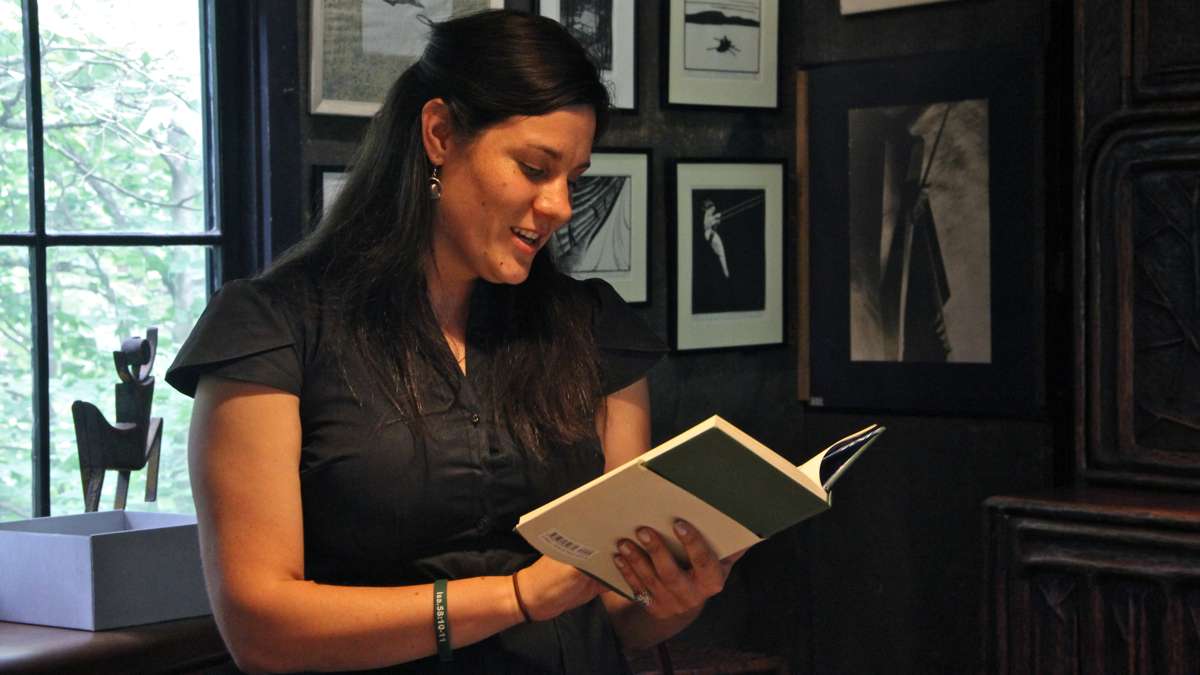Woodblock prints from first steps of Wharton Esherick’s career published again
-

A newly printed version of the book by Mary E. Marcy, illustrated with woodcuts by Wharton Esherick, stands beside a 1922 first edition. (Emma Lee/WHYY)
-

The woodcuts for Rhymes of Early Jungle Folk were Wharton Esherick's first foray into woodworking. (Emma Lee/WHYY)
-

An original woodcut block by Wharton Esherick for the frontispiece of Rhymes of Early Jungle Folk. (Emma Lee/WHYY)
-

Mary Marcy's verses were intended to teach children about evolution. (Emma Lee/WHYY)
-

All the woodcut blocks for Rhymes of Early Jungle Folk have been preserved at the Wharton Esherick Museum. (Emma Lee/WHYY)
-

Curator Laura Heemer reads from a freshly minted copy of Rhymes of Early Jungle Folk at the Wharton Esherick Museum in Paoli. (Emma Lee/WHYY)
-

Sculptures, furniture and woodcuts abound in the home studio of Wharton Esherick, now a museum, in Paoli. (Emma Lee/WHYY)
-

Wharton Esherick's efficient use of space can be seen in his bedroom, preserved as he left it. (Emma Lee/WHYY)
-

A gleeming wood countertop and countertop fireplace are two unusual features in Wharton Esherick's kitchen. (Emma Lee/WHYY)
-

Wharton Esherick built his home and studio in Paoli according to his own designs, with the help of some friends. (Emma Lee/WHYY)
The first carved woodblock prints by Wharton Esherick, an artist who was a major figure in American crafts, have just been republished. They illustrated “Rhymes of Early Jungle Folk,” a book of children’s verse, published in 1922.
Pieces by Esherick, known for his expressive, modernist furniture and wood sculpture, are now collected by major museums around the world. But he started as a painter at the Pennsylvania Academy of the Fine Arts in Philadelphia.
Unfortunately, nobody wanted his paintings.
“He started carving frames, hoping they would enhance their appeal,” said Laura Heemer, acting curator at the Wharton Esherick Museum at the house and studio hand-built by Esherick in Paoli, Pennsylvania. “Most people wanted the frames, not the paintings.”
In 1920, he met political activist Mary Marcy, who wrote about workers rights for the International Socialist Review. She took aim at meatpacking companies and social charities. When she was fired from a secretarial job for wearing a political button, famed civil libertarian attorney Clarence Darrow came to her aid, securing her a new job.
When not writing muckraking articles for the radical left, she wrote poems for children explaining evolutionary theory. Marcy asked Esherick if he would illustrate her poems for a book. He decided to carve woodblocks for printing.
The resulting book, “Rhymes of Early Jungle Folk” was published three years before the landmark Scopes Monkey Trial in Tennessee, wherein evolutionary theory went up against religious creationism in a court of law. In that trial, which sparked a national conversation about secular versus religious values, Marcy’s friend Darrow argued for the secular.
“She was interested in the evolution movement earlier than anyone else,” said Heemer. “I don’t know what she was on to. The rumblings were starting and she jumped on the boat.”
For Esherick, the project pushed him away from painting into woodworking, which he did for the rest of his life. He carved hundreds of illustrations for almost 15 years, then went on to make avant-garde furniture and sculpture that would be his legacy.
These original woodblocks, some in swirling, round shapes like mandalas, show the start of his dynamic style.
“Something Wharton is really known for — take something that isn’t moving and illustrate the motion,” said Heemer. “He did that in his sculpture, and we can see he did it in his woodblocks as well.
For Marcy, the book did little to improve her circumstances. During World War I, she was persecuted for her political aspirations. While working on the book with Esherick, she watching the radical left crumble, and she committed suicide a few weeks after publication.
“I wish her seed had fallen on an artistic ground instead of political, her strength of conviction, her playful philosophy would have created much, much more,” wrote Esherick in a memorial pamphlet for Marcy. “How we did play in our letters. It was business, but we played together and had fun.”
Esherick created 100 woodblock prints for “Rhymes of Early Jungle Folk,” 78 of which were used. The other 22 are missing.
WHYY is your source for fact-based, in-depth journalism and information. As a nonprofit organization, we rely on financial support from readers like you. Please give today.





